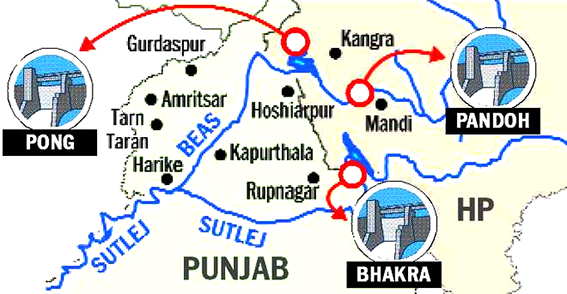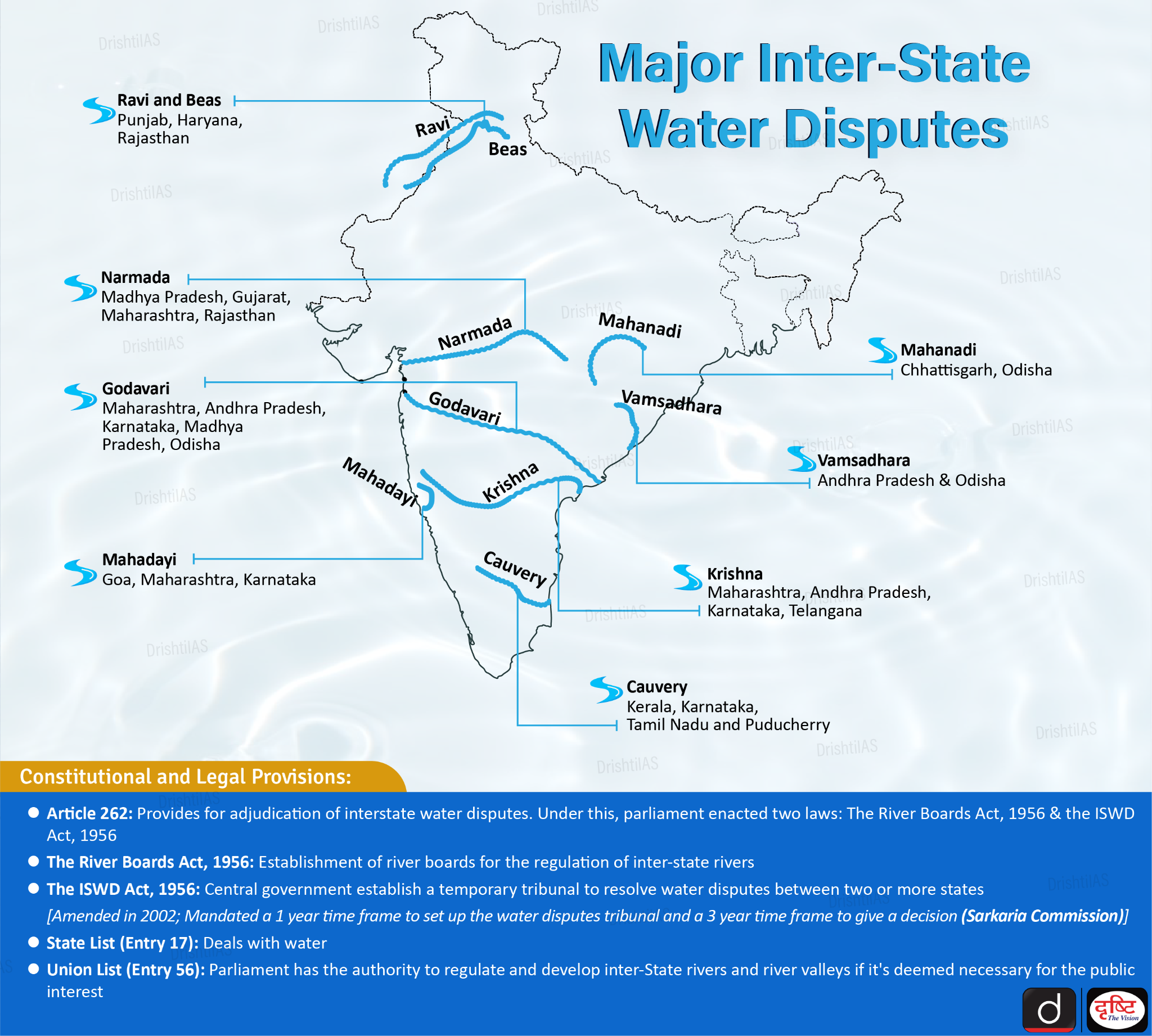Governance
Punjab-Haryana Water Sharing Dispute
- 08 May 2025
- 10 min read
For Prelims: Supreme Court, Punjab Reorganisation Act, 1966, Beas-Satluj Link Project, Tehri Dam, Article 262, Interstate River Water Disputes Act, 1956, Inter-state Council, PMKSY.
For Mains: Punjab-Haryana water sharing dispute, Inter-state water dispute and resolution.
Why in News?
Punjab opposes the Bhakra Beas Management Board (BBMB)’s decision to release an additional 4,500 cusecs of water to Haryana.
- Meanwhile, Haryana has threatened to move the Supreme Court to secure its share, escalating a decades-old dispute over sharing the water of Bhakra Nangal Dam.
What are the Key Facts Regarding the Punjab-Haryana Water Sharing Dispute?
- Current Crisis: Haryana demanded 8,500 cusecs from the Bhakra-Nangal project—4,500 cusecs more than its current allocation. Punjab refused, forcing the BBMB to intervene.
- In a BBMB meeting, Haryana, Rajasthan, and Delhi voted in favor of releasing extra water.
- Punjab has refused to open additional sluice gates, leading Haryana to approach the Supreme Court.
- Role of BBMP: Before the division of Punjab in 1966, the Bhakra-Nangal project was managed by Punjab. In 1966, the Bhakra Management Board (BMB) was formed under the Punjab Reorganisation Act, 1966 to oversee the project, ensuring it benefited Punjab, Haryana, and Himachal Pradesh.
- BMB was renamed BBMB in 1976, it now manages Bhakra Dam (Himachal), Nangal Dam (Punjab), Beas-Satluj Link Project (Pandoh Dam), and Pong Dam.
- Bhakra Nangal Dam: It comprises two separate but complementary dams on the River Satluj i.e., the Bhakra dam in Himachal Pradesh, and the Nangal dam (10 km downstream in Punjab).
- It is India’s 2nd tallest dam after the Tehri Dam and its reservoir is known as the Gobind Sagar.
- It is a joint venture of 3 state governments - Rajasthan, Haryana, and Punjab.
- After, creation of Haryana, the Satluj-Yamuna Link (SYL) canal was proposed to deliver Haryana’s share but remains incomplete due to Punjab’s resistance.

Why are Punjab and Haryan Facing a Water Crisis?
- Groundwater Depletion: Groundwater depletion has become a serious concern in Punjab, Rajasthan, and Haryana, where the extraction rate has exceeded the recharge rate by 66, 51, and 34%, respectively.
- Falling Water Levels: Dams like Bhakra, Pong, and Ranjit Sagar are experiencing significantly lower water levels, attributed to reduced snowfall in the Himalayas, which feeds these rivers.
- Agricultural Practices: Water-intensive crops, especially rice, have worsened groundwater depletion.
- Subsidies for electricity and free water in states like Punjab and Haryana encourage unregulated pumping.
- Indus Waters Treaty (1960): The treaty limits India’s access to the western rivers (Indus, Chenab, Jhelum), vital for irrigation in Punjab and other states, causing regional water stress.
- Urban & Industrial Demand Surge: Rapid urbanization in cities like Chandigarh, Gurugram, and Ludhiana has increased domestic water demand, while thermal power plants and industries further strain limited water resources.
What is the Interstate River Water Dispute?
- About: Interstate river water disputes arise when two or more states disagree over the usage, distribution, or control of rivers that flow across their boundaries.
- Causes:
- Riparian Rights: Conflicts between upstream and downstream states over equitable water distribution.
- Water Sharing Agreements: Ambiguities in agreements often fuel disputes when one state feels aggrieved by unequal shares or unfair allocations.
- Water Scarcity & Climate Change: Increased competition due to droughts and changing weather patterns.
- Political and electoral considerations complicate dispute resolution.
- Agriculture vs Industry: Tensions between agricultural and industrial water needs.
- Economic Disparities: Wealthier states with better infrastructure dominate water access.
- Legal Delays: Prolonged tribunals or Supreme Court judgments delay resolution.
- Constitutional Provisions:
- Entry 56 of the Union List: It grants the Union Government authority to regulate and develop inter-state rivers and river valleys, as deemed necessary by Parliament for public interest.
- Entry 32 of the Concurrent List: It is related to shipping and navigation on inland waterways as regards mechanically propelled vessels, and the rule of the road on such waterways.
- Entry 17 of the State List: It pertains to water, covering aspects such as water supply, irrigation, canals, drainage, embankments, water storage, and hydro power.
- Disputes Resolution Provisions:
- Constitution: According to Article 262, in case of disputes relating to waters:
- Parliament has the authority to enact laws for the adjudication of any dispute or complaint regarding the use, distribution, or control of waters in any inter-State river or river valley.
- Parliament may, through legislation, specify that neither the Supreme Court nor any other court shall have jurisdiction over such disputes or complaints as mentioned above.
- Statutory: As per Article 262, the Parliament has enacted:
- River Board Act, 1956: This empowered the Union government to establish Boards for Interstate Rivers and river valleys in consultation with State Governments. So far, no river board has been established under this Act.
- Inter-State Water Dispute Act, 1956: If a state or states request a tribunal, the Central Government should first try to resolve the issue through consultation. If unsuccessful, it may then constitute the tribunal.
- The Supreme Court shall not question the Award or formula given by tribunal, but it can question the working of the tribunal.
- It was amended in 2002 that specified a one-year deadline for the establishment of a water disputes tribunal and a three-year deadline for delivering a decision as per the Sarkaria Commission recommendations.
- Constitution: According to Article 262, in case of disputes relating to waters:
- Major Interstate River Water Disputes:
How to Solve Interstate River Water Dispute?
- Strengthening Institutional Frameworks: Amend the Interstate River Water Disputes Act, 1956 to include penalties for non-compliance (such as reduction of central funding), and the establishment of a single permanent tribunal (as proposed in the 2019 amendment) with specialized benches.
- Cooperative Federalism & Mediation: Introduce mediation and negotiation before litigation, involving neutral mediators such as retired judges and hydrologists, alongside political dialogue through platforms like PM-led inter-state council.
- Scientific Water Management: Provide subsidies for drip and sprinkler irrigation (similar to PMKSY) and promote crop diversification to reduce water-intensive crops like sugarcane in drought-prone areas.
- Rainwater Harvesting: Implement a national policy for aquifer recharge and penalize over-extraction of groundwater (e.g., Punjab’s depleting resources) to ensure sustainable water usage.
- The INDIA-Groundwater Resource Estimation System (IN-GRES), which tracks and maps groundwater extraction, should be implemented nationwide for effective groundwater management based on its criticality.
- Balanced Infrastructure Development: Ensure equitable water infrastructure development that balances the interests of all states, while promoting decentralized conservation to reduce reliance on large-scale structures amid climate change and variable river flows.
Conclusion
The Punjab-Haryana water dispute highlights the complexities of interstate river water sharing, exacerbated by legal, political, and environmental challenges. Effective resolution requires strengthening institutional frameworks, fostering cooperative federalism, implementing scientific water management, and ensuring equitable infrastructure development to address the needs of all states and promote sustainable water use.
|
Drishti Mains Question: Q.Examine the causes and challenges of interstate river water disputes in India. How can the existing legal and institutional frameworks be strengthened to ensure timely resolution? |
UPSC Civil Services Examination, Previous Year Question (PYQ)
Mains
Q. Constitutional mechanisms to resolve the inter-state water disputes have failed to address and solve the problems. Is the failure due to structural or process inadequacy or both? Discuss. (2013)








